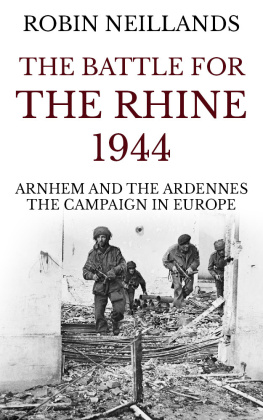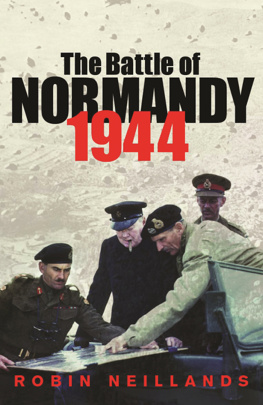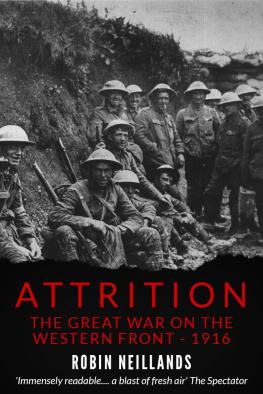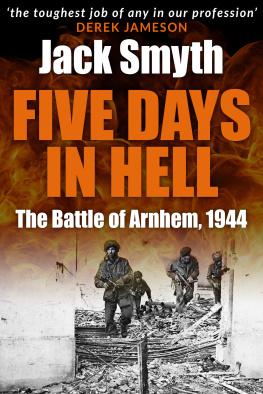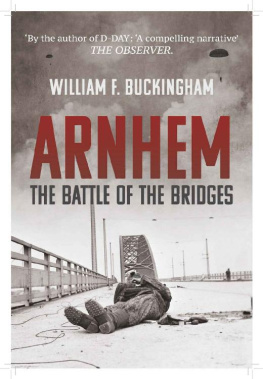The Battle for the Rhine 1944
Arnhem and the Ardennes: the Campaign in Europe
Robin Neillands
Copyright Robin Neillands 2014
The right of Robin Neillands to be identified as the author of this work has been asserted by her in accordance with the Copyright, Designs and Patents Act, 1988.
First published in the United Kingdom in 2005 by Hodder and Stoughton
This edition published in 2014 by Weidenfeld & Nicolson.
This one is for Dr Nick Plowman and all the staff at the Radiotherapy and Chemotherapy Departments of the Cromwell Hospital, London, with my grateful thanks.
I would never have completed it without them.
Table of Contents
The success of a commander does not arise from following rules or models. It consists in an absolutely new comprehension of the dominant facts of the situation at the time and all the forces at work. Every great operation of war is unique. What is wanted is a profound appreciation of the actual event. There is no surer road to disaster than to imitate the plans of bygone heroes and fit them to a novel situation.
WINSTON S. CHURCHILL, LIFE OF MARLBOROUGH
About This Book
A commander likes to be popular but it isnt essential. The essential thing is to win.
MAJOR-GENERAL JULIAN THOMPSON, CB, OBE
This is the fourth book I have written about the campaigns in France and North-West Europe between D-Day, 1944 and VE Day, 1945. This is also the last one I shall write on the Second World War campaigns, and it is perhaps fortunate that I came to it when the others have been mulled over and the background to the events that took place between the Normandy breakout and the end of the Battle of the Bulge has already been explored. This book has proved the most difficult and the most complicated of the four and I am glad I came to it with a certain amount of experience under my belt.
My niche in the field of military history, such as it is, is as a myth buster. I like to find a story and see if it is true, or entirely true, or partly composed of fact and partly of make-believe. I believe that in the period covered in this book, one glaring myth needs ventilating: the story of why Market Garden failed to achieve all it might have done, and why XXX Corps did not get to the Arnhem Bridge on D plus 2 of the operation, as they could have done. The chapters covering this part of the post-Normandy campaign make up the core of the book.
The previous books were not written in order of event. D - Day 1944 , written with Major Roderick de Normann, came in 1994, to mark the fiftieth anniversary of the Normandy landings. This was followed by The Conquest of the Reich , which picked up the Allied story after the Battle of the Bulge and carried it forward to VE Day. Then in 2002, came The Battle of Normandy . Copies of these books lie on my desk; I notice that each one is fatter than the last, the result of getting deeper into the subject and more involved with relevant events off the battlefield.
After writing about the Battle of Normandy it seemed logical to complete the task and bridge the gap between the end of the Normandy campaign in September 1944 and the end of the Battle of the Bulge in January 1945: so covering the post-Normandy period, when the Allied Armies were attempting to close on the Rhine. This task was undertaken before I fully realised how complicated and controversial the 1944 campaign for the Rhine had been.
Taken as a whole, the European war in the autumn and early winter of 1944-45 has been somewhat neglected by military historians. Perhaps this is because the campaign has no obvious end, or because British and Canadian attention has been attracted by the Battle of Arnhem, the Walcheren assault and the Battle of the Scheldt, while the Americans are drawn more to the epic Battle of the Bulge and the bitter struggles around Aachen and in the Huertgen Forest. For whatever reason, books on this period as a whole are a trifle thin on the ground. It is also possible, even probable, that the complex issues of the period have driven away many wise historians to more clear-cut conflicts.
The story of this time is not easy to unravel, but for this writer at least, the chief attraction of the period lies in its characters and its complexity. How to explain and evaluate the interlinked problems of command, terrain, logistics, strategy, policy, Anglo-US relations, press comment, Washington politics and, last but by no means least, the personalities and ambitions of the various Allied commanders, has kept me busy and fascinated for the last three years.
Looking back, the original idea was quite simple to examine the various battles that took place in North-West Europe between the Normandy breakout and the end of the Bulge: Operation Market Garden, better known in Britain as the Battle of Arnhem, Aachen, the Huertgen Forest, Walcheren, the Scheldt, the Saar, Metz, Lorraine, the Colmar Pocket and the Bulge itself; and see how they contributed or detracted from the overall strategy of the campaign. At which point in the research I ran into difficulty. I was unable to see what exactly the strategy was for this campaign indeed, this book might well be sub-titled Battles in Search of a Strategy .
If this seems odd, let me explain. While every military historian approaches the task in his or her own way, my method is to regard the strategy best imagined as the overall plan for a particular campaign as the blueprint for that campaign and the various battles as steps contributing towards the achievement of the campaigns objectives.
For example, during the Normandy campaign Allied strategy was always clear, though subject to change: change is understandable, for strategy is not set in stone. After the D-Day assault, the British Second Army would hold the left flank of the bridgehead, while the US First Army took the port of Cherbourg. In other words, the first strategic requirement for the two Allied armies in Normandy was to hold the left flank of the bridgehead and capture the port of Cherbourg. Other factors might intervene but nothing must detract from those two strategic aims, both of which were vital to the successful outcome of the entire campaign.
Then the strategy changed somewhat. Having taken Cherbourg, the US First Army must then secure the city of St La as the start line for the eventual breakout, while the British and Canadians, though still holding the eastern flank of the bridgehead secure, must also attract as many German panzer divisions as possible onto that eastern flank and wear them down in battles of attrition around Caen.
Finally, at the end of July, the US First Army, later joined by the Third Army, broke out in the West and combined with the British and Canadian forces to push the German armies Seventh Army and Fifth Panzer Army across the Seine in headlong retreat.
The point is that there was always a clear Allied strategy in Normandy. This overall strategy was worked out before D-Day by the British commander of 21st Army Group and Ground Force Commander for the invasion phase of Operation Overlord General Sir Bernard Law Montgomery, a man better known as Monty, and approved by the Supreme Allied Commander, General Dwight D. Eisenhower known to all as Ike and this strategy duly delivered victory in the Normandy campaign.
My task in the Normandy book was therefore relatively simple to slot the various battles of that campaign at Villers-Bocage, Cherbourg, Caen, in the bocage, at St L, Hill 112, Vire, Mont Pinchon, Mortain, Falaise, together with Allied operations like Perch, Jupiter, Epsom, Goodwood, Cobra and the rest into that strategy, and see how they contributed to the final outcome.
The Normandy campaign was not without its glitches and difficulties and accusation of incompetence, plus a goodly layer of self-serving myth. The various controversies about that campaign and those battles flourish to this day, but the strategy the broad picture, the background to events, the basic plan was always clear, at least to those at SHAEF not totally devoted to destroying the career and reputation of General Montgomery.

